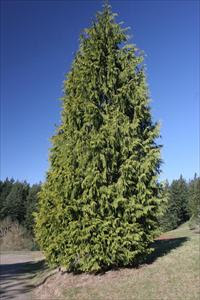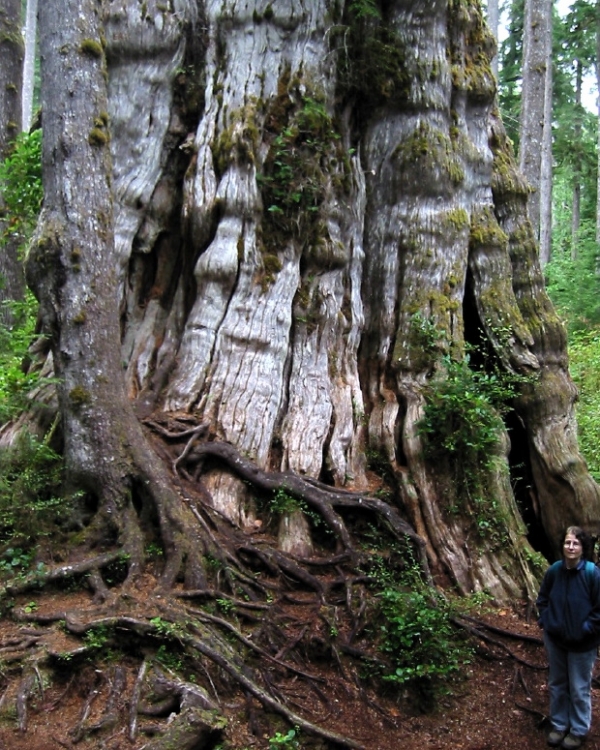Western Redcedar
 Thuja plicata, commonly known as Western Redcedar, is native to the Pacific Northwest and a is a popular, sturdy, and graceful evergreen frequently used in tall hedges or as a privacy screen.
Thuja plicata, commonly known as Western Redcedar, is native to the Pacific Northwest and a is a popular, sturdy, and graceful evergreen frequently used in tall hedges or as a privacy screen.
 Southwest Oregon is near the most southern edge of Western Redcedar’s range, which extends north into Washington and British Columbia. The largest Redcedars in the world are true forest giants, and can be found in the rainforests of the Olympic Peninsula, where several trees near 200’ tall by 60’ wide have been found.
Southwest Oregon is near the most southern edge of Western Redcedar’s range, which extends north into Washington and British Columbia. The largest Redcedars in the world are true forest giants, and can be found in the rainforests of the Olympic Peninsula, where several trees near 200’ tall by 60’ wide have been found.
Because the climate here in the Rogue Valley is hotter and drier that that of the Olympic Peninsula, plants here will generally get about 50-70’ all and 15-25’ wide at maturity, if left untrimmed.
 Western Red Cedars look great when left in their natural shape, but they also respond extremely well to shearing or pruning. They grow at a moderate rate – roughly between 15-24”/year – and are generally pest and disease resistant. They’re also very pollinator-friendly, and serve as host plants for dozens of native butterflies and moths. Once established, Western Redcedar is relatively drought tolerant, and will generally only require deep watering once or twice a month.
Western Red Cedars look great when left in their natural shape, but they also respond extremely well to shearing or pruning. They grow at a moderate rate – roughly between 15-24”/year – and are generally pest and disease resistant. They’re also very pollinator-friendly, and serve as host plants for dozens of native butterflies and moths. Once established, Western Redcedar is relatively drought tolerant, and will generally only require deep watering once or twice a month.
As a group, Thujas of multiple species are widely used as hedges and privacy screens. They’re all easy to grow, relatively fast growing, have nice densely pyramidal shapes, and are tolerant of clay soils as long as the soils aren’t soggy. You will want to cage them to protect them from deer when they are young, but they grow quickly enough that you’ll only likely going to need to do this for the first few years.
 Shooting Star Nursery carries several different kinds of Thuja in large pots and as ball & burlap plants: Western Redcedar (T. plicata), Virescens and Excelsa – T. plicata cultivars, Green Giant and Virginian – hybrids of a cross between T. plicata and T. standishii (Japanese Arborvitae), and Emerald Green – a T. occidentalis (Northern White Cedar) cultivar. See the table below for more information.
Shooting Star Nursery carries several different kinds of Thuja in large pots and as ball & burlap plants: Western Redcedar (T. plicata), Virescens and Excelsa – T. plicata cultivars, Green Giant and Virginian – hybrids of a cross between T. plicata and T. standishii (Japanese Arborvitae), and Emerald Green – a T. occidentalis (Northern White Cedar) cultivar. See the table below for more information.
Fun fact: One of the common names for Thuja is Arborvitae (Latin for Tree of Life). Early French settlers to North America gave it that name when they encountered an east coast Thuja species (T. occidentalis), and learned from Native Americans in the region of the many uses the plant had: decay-resistant wood for building canoes and houses, sturdy fibrous bark used for clothing and cording, and roots and leaves with a variety of medicinal purposes.
| Botanical Name | Growth Rate/Year | Mature Height | Mature Width | |
| Western Redcedar | Thuja plicata | 15-24″ | 50-70′ |
15-25′ |
| Virescens | T. plicata cultivar | 18-24″ | 20-30′ | 9-12′ |
| Excelsa | T. plicata cultivar | 20-36″ | to 40′ | 15-20′ |
| Green Giant | T. plicata x T. stanfordii | 3-5′ | 25-30′ | 10-12′ |
| Virginian | T. plicata x T. stanfordii | up to 3′ | 15′ | 6′ |
| Emerald Green | T. occidentalis | 12-15″ | 12-15′ | 3-4′ |
